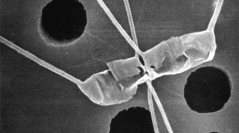

 Cryptogamie, Algologie
30 (2) - Pages 125-134
Cryptogamie, Algologie
30 (2) - Pages 125-134Chaetoceros similis is a marine planktonic diatom originally described by Cleve in 1896. It is relatively well-known in the phytoplankton of the North Atlantic Ocean, interior or semi-closed seas in the Northern hemisphere and the North Pacific Ocean. This study investigates its morphological variability based on samples collected during the summer of 2003 in Roscoff, Britanny (France). Chaetoceros similis occurred mostly as a solitairy form but sometimes it also formed short chains composed of up to 6 cells. In the chains, the sibling valves of intercalary cells were connected to each other by the valve faces, which were inflated at the centre. The valves had a pattern of costae running from slightly eccentric annuli, and only the terminal valves showed a central rimoportula. All setae, which arose from the valve apices, were straight and directed at an angle of 30-35° with respect to the apical axis; sibling setae in chains did not fuse together. In a few specimens, particularly in the short chains, some teratological forms were seen: one intercalary valve had only one thicker seta at one apex and lacked the other seta at the corresponding apex, but valves with three setae were also found while cells in other shorter chain had only a single terminal seta per valve. This latter morphotype resembled another Chaetoceros species, Chaetoceros throndsenii. In the short chains, the nature of the cells linked by the inflated valve faces and the lack of fusion of sibling setae may partially explain certain morphological variations in the number and structure of sibling setae.